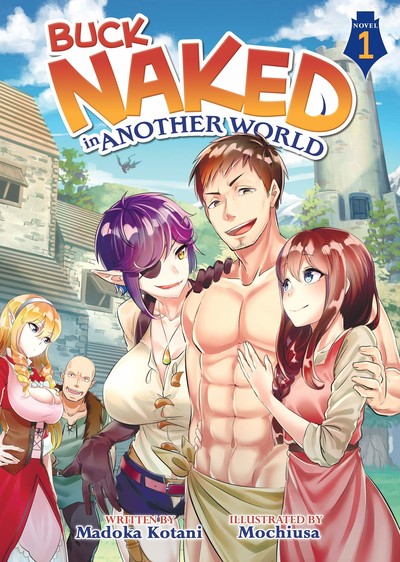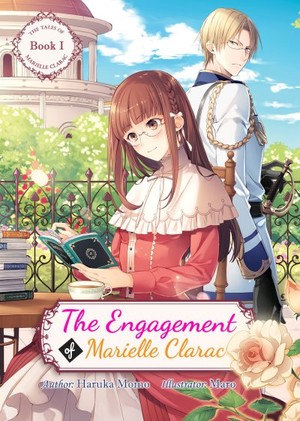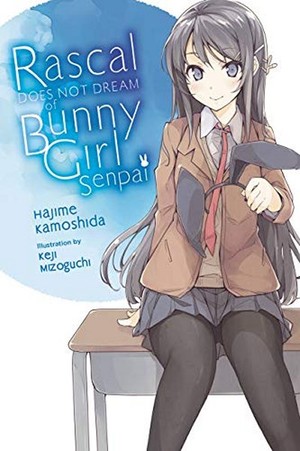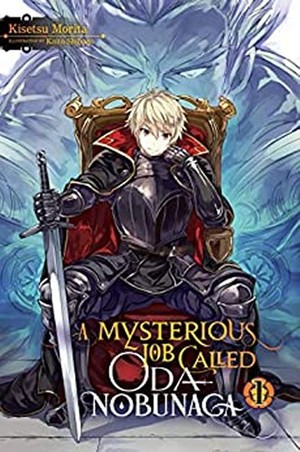The Spring 2020 Light Novel Guide Part II
by Rebecca Silverman,
Light novel titles have almost become a joke unto themselves. For every The Engagement of Marielle Clarac (simple, to the point) we have something far more out there, like Yen On's July release of I'm a Behemoth, an S-Ranked Monster, but Mistaken for a Cat, I Live as an Elf Girl's Pet, which is so over-descriptive that it could count as the back copy for the book. While we may assume that titles skew more on the side of the latter, the three months covered in this guide indicate that, in English translation at least, there's much more of a balance than anyone might expect. That's a positive, because like with any type of book, many light novels have the potential to appeal to a readership outside of the anime and manga fandom – but trying to convince someone to read Rascal Does Not Dream of Bunny Girl Senpai is a little bit trickier than getting them to pick up At Night, I Become a Monster, despite the fact that they share real thematic similarities. But whether the protagonist is Buck Naked in Another World or trying to figure out what to do with A Mysterious Job Called Oda Nobunaga, there's always something interesting to read about, and whatever your feelings about titles, we can all be happy about that.
Below are the final six novels up in the guide—you can check out the first half here!
April
 Buck Naked in Another World
Buck Naked in Another World
By Madoka Kotani. Illustrated by Mochiusa. Seven Seas, $9.99 digital.
Synopsis:
Shuta Yoshida isn't sure how he went from walking to a bar after work to being totally naked in another world's forest, but that's what happened. Taken in by the small village of Apegut, Shuta goes from being a distrusted outsider to a married hunter relatively quickly, mostly because his new wife's father was recently killed by a wyvern and they need another hunter. Shuta (or “Shooter,” as the villagers call him) is just beginning to settle in when he's sent on a mission to the city, where he gets caught in a thug's trap and ends up enslaved. Will he ever get back to Apegut and his new wife, whom he hasn't even slept with yet? And how does he keep losing his clothes?
Thoughts:
Buck Naked in Another World is an almost fifty-fifty blend of precisely what you'd expect and totally unexpected. On the “I saw that coming” front, we have just what the title advertises: Shuta is whisked away to another world, where he arrives totally naked and remains mostly or fully unclothed for the duration of the volume. This brings with it the usual penis jokes, erection gags, and a decently impressive array of euphemisms, “pork sword” standing out as one I hadn't heard before. The author has a light enough hand with all of this that it does largely remain funny, and Shuta's narrative voice is self-aware enough that he's likable as a protagonist – really, the poor guy just wants some pants but is willing to make the best of what he's stuck with. But “what he's stuck with” turns out to be rather more than you might envision in this kind of light novel: not only is there a fair amount of violence in the story, but he also becomes enslaved at one point and meets another Japanese person who has had a much worse time than he has since coming to this otherworld. Gangi Mari (or Ganjamary as the poor girl is now called, much like Shuta became Shooter) also arrived in the buff, but it's strongly implied that she was assaulted and is now addicted to “potions,” which are your basic RPG pots but with side effects that mimic illegal drugs. This is where the fact that Shuta is thirty-two also comes in – Mari was the usual age for someone to be isekai'd away (high school), and her experience versus his feels like it might be a bit of a statement on genre tropes. It's not dwelt upon, but Shuta definitely notices. This balance of elements does make the book harder to recommend strictly as a comedy, but between the darker parts and Shuta's unusual age, as well as the fact that he's not creepy and this isn't a harem, make it different enough that it's worth reading for something just a little different in the isekai line.
 The Engagement of Marielle Clarac
The Engagement of Marielle Clarac
By Haruka Momo. Illustrated by Maro. J-Novel Club, $6.99 digital.
Synopsis:
Marielle Clarac is the daughter of a minor noble and an incurable fangirl. She's established herself (under a nom de plume) as a successful author of romantic fiction by perfecting her wallflower ways in order to observe the actions of those around her, but even she doesn't see the proposal by the much higher-ranked Lord Simeon Flaubert coming. Marielle accepts, but she's in the dark as to why he would have proposed to her in the first place. Of course, she does have some ideas…
Thoughts:
Like with Can Someone Please Explain What’s Going On?!, The Engagement of Marielle Clarac has one very specific linguistic issue that keeps it from being a fully enjoyable book: anachronistic language. Unlike that other novel, however, the issue here is one particular phrase – Marielle continually refers to herself as a “fangirl” and says that she “fangirls hard,” causing her to have nosebleeds, which is completely at odds with the formal pseudo-19th century language and European setting that the rest of the book is written in. That makes each use of the word stand out like the proverbial sore thumb, and it absolutely took me out of the story every single time. That's a shame, because Haruka Momo has done an otherwise very nice job of approximating 19th century Europe (although her French is a bit suspect; the country is called “Lagrange,” which means “the barn” and there's a Duke Brassiere in there) and there certainly are adequate antiquated substitute terms – something that Momo's near-perfect approximation of what sensation and sentimental novels were like indicates that she might have known. Of course, Marielle herself is a bit annoying, more so as the book goes on, so language may not have been enough to fully save the story; the most engaging chapter is actually the one narrated by Simeon. Marielle's chief fault is that she's nowhere near as clever as she thinks she is, and that wears on you, especially in the second storyline in the novel, where she's trying to catch a mysterious thief known as Lutin, with the answer to who he is blatantly obvious to the reader but somehow eluding Marielle herself. While I didn't actively dislike the book, it also didn't hold my interest as it went on, making it feel very long for a relatively short novel.
 The Extraordinary, the Ordinary, and SOAP!.
The Extraordinary, the Ordinary, and SOAP!.
By Nao Wakasa. Illustrated by ICA. J-Novel Club, $6.99 digital.
Synopsis:
Lucia Arca is a laundrymaid working at the royal palace in the royal capital, a job for which she's uniquely suited because the only magic she can use is an odd spell she calls “soap” – it unleashes a cloud of magical soap bubbles that can remove any stain. But what she doesn't know is that it's not just fabric that she can cleanse – if cast on a person, it can also soothe their troubled mind. When monsters attack the capital and she uses the spell as a last resort and it stops the beasts dead in their tracks, Lucia is tapped by the king to go join the party of the Sacred Maiden (a girl summoned from another world) in order to help her cleanse the clouded magic crystals that power the land. Lucia's not sure she really belongs there, but who is she to deny the king? If she can help, she'll do her best.
Thoughts:
The Extraordinary, the Ordinary, and SOAP! is not only a lot of fun to read, it's also an interesting take on the isekai novel craze – like Yen On's Defeating the Demon Lord's a Cinch, it's told from the point of view of an ordinary citizen of the “other” world, Lucia, a village girl turned laundrymaid because she has the weird magical ability to remove stains. But Nao Wakasa's story goes even further than Tsukikage's variant: it acknowledges that out of all of the hundreds of people isekai'd away, some of them just aren't going to be all that happy about it. Enter Maria Nishime, a sixteen-year-old girl whose unpleasant personality is at least half because she's so miserable and scared all the time after having been removed from modern day Japan and plopped down into a medieval-style world. Lucia's the only person who bothers to see her as something beyond the Sacred Maiden, and that's part of her appeal as a heroine – she's basically a nice person. She's not too nice, fortunately, and does have her own clear personality, one which makes it easy to see why Sir Celestino the knight is madly in love with her, even if she's only marginally aware of the fact. What she's all too aware of is that he's a knight and she's an orphaned laundrymaid, so there's a sense that she may be deliberately hiding her own feelings and suspicions from herself so as not to get too involved in something that ends badly. This sets her a bit apart from heroines like Katarina Claes and Lady Elianna, because it's not that she's truly oblivious; she really could be said to be looking out for herself even if she's only doing it subconsciously. In addition to her appeal as a heroine (and Celes as a romantic interest; that's pretty well wrapped up and there aren't likely to be other major contenders for her heart), the story itself is breezily written and is incredibly readable, consisting of short chapters and a fast-moving plot, with three from Celes' perspective to balance things out. There are definitely some dark moments, such as the attack on the capital and the awful, awful cliffhanger the book ends on, but mostly this feels like a bit of fresh air in a genre that badly needs it and just a fun novel overall. It even makes a case for laundry being fun under the right circumstances, and that isn't something I ever thought I'd say.
 The Hitchhiker's Guide to the Isekai
The Hitchhiker's Guide to the Isekai
By Sakka Seihan. Illustrated by Shinobu Shinotsuki. J-Novel Club, $6.99 digital
Synopsis:
How do you write an isekai novel? By getting whisked away to another world, obviously. Six isekai authors detail their own experiences traveling to another world and give solid advice for what to do when it inevitably happens to you.
Thoughts:
Like any collection of essays or short stories by a group of authors, this is a mixed bag. In the case of this specific book, the first two pieces, by Carlo Zen (The Saga of Tanya the Evil) and Tappei Nagatsuki (Re:Zero) are far and away the strongest. Zen pens a full-on guide to what to do when you manage to figure out how to be “isekai'd” away in the vein of Diana Wynn Jones' The Tough Guide to Fantasyland, i.e. with tongue firmly in cheek, while Nagatsuki's is the most readable of the batch: he decides to throw himself in front of a truck on the highway in order to meet a goddess and get reincarnated in another world. This “essay” is so successful because Nagatsuki not only mimics the style and format of Konosuba and, to a degree, The Hero is Over Powered but Overly Cautious, but he also zeroes in on many of the sillier tropes of the genre, from bonus points to how rare or fancy the truck that hits you is to how overworked the divine world is with all of these fools trying to be reborn in another world. Other contributors are Natsuya Semikawa (Otherworldly Izakaya "Nobu"), Hoko Tsuda, Hyuganatsu, and Katsuie Shibata, and they write with varying degrees of humor. The book isn't going to work for everyone (although it's almost worth it for the Nagatsuki essay alone, regardless), but it is fun to see creators make fun of themselves and a trend they've all participated in.
 Rascal Does Not Dream of Bunny Girl Senpai
Rascal Does Not Dream of Bunny Girl Senpai
By Hajime Kamoshida. Art by Keji Shimoguchi. Yen On, $15 print, $7.99 digital.
Synopsis:
After his sister experienced extreme emotional distress from being bullied at school which manifested on her body physically, Sakuta firmly believed in Adolescence Syndrome – and even found himself with the scars to prove it. Moving to go to a different school where nobody knew them, Sakuta nevertheless found himself the subject of distorted rumors, but decides that combating them is just too much trouble, because arguing with the air isn't productive. Then one day he sees a girl from school in the library dressed like a bunny girl – and he realizes that he's the only one who sees her. Mai has wished to avoid scrutiny, and slowly her wish is taking on an ominous shape.
Thoughts:
Where most light novel titles tell you with almost too much detail what their covers contain, Rascal Does Not Dream of Bunny Girl Senpai takes the opposite route – its title really doesn't make a whole lot of sense. (See also Is It Wrong to Try to Pick Up Girls in a Dungeon?.) For one thing, no one ever calls Sakuta “Rascal” or even “a rascal,” and he's definitely thinking about or dreaming of Mai, his senpai from school whom he first encounters in the library wearing a bunny girl costume. The title, in fact, conceals a story that takes the overplayed idea of “adolescence syndrome” (chuunibyou) and uses it to reflect on the nature of wishes and belief, all wrapped up in a light novel package. By this I mean that there certainly are a fair amount of the usual tropes floating around here, from Kaede's questionable love for her brother to Rio's quirkier-than-thou personality, to say nothing of the way that Sakuta comes off as the typical bland underdog for much of the novel. But these are filtered through the growing realization that Kaede's wounds manifested physically because her psyche couldn't cope with the bullying, Sakuta's mysterious scars are the expression of his feeling of having to fight for his sister's well-being, and Mai's invisibility is the result of her wanting to vanish from her mother's sight so that she can exert some control over her own life. Equally interesting and important is the way that these physical reactions/manifestations go out of their creators' control, mimicking the way that feelings really can snowball, whether during adolescence or any time we're under duress. That Sakuta has to actively fight to regain control of his own emotions in order to save Mai from her out-of-control wish again drives the point home for an ending that's not just happy, it's hopeful, even as it leads into Sakuta's next (mis)adventure. There are some real issues, particularly in the first two chapters, which, among other things, have Sakuta accusing a girl being mean to him of having her period as an explanation, which is a little bit of misogyny the novel could have done without, but by chapter three, things are falling into place. It's worth getting through the problems for the rest of the story.
May
 A Mysterious Job Called Oda Nobunaga
A Mysterious Job Called Oda Nobunaga
By Kisetsu Morita. Illustrated by Kaito Shibano. Yen On, $15 print, $8.99 digital.
Synopsis:
In this land, at age eighteen everyone goes to the church to be given a special job ordained by the gods. Most times it doesn't do much beyond enhance someone's already-present interests and skills, but every so often, someone gets a very special message. That's the case for Alsrod Nayvil, the second son of a viscount, although he doesn't understand it at the time: the gods proclaim his job to be “Oda Nobunaga.” As it turns out, this means that Alsrod has the voice and guidance of the great warlord Oda Nobunaga at his disposal, and in layman's terms, what his job really amounts to is “conqueror.”
Thoughts:
A Mysterious Job Called Oda Nobunaga comes to us from the same pen as I've Been Killing Slimes for 300 Years and Maxed Out My Level, so it isn't surprising on a couple of fronts. The first is that it involves a form of the isekai genre, and this is perhaps the most interesting element of the story. Rather than the protagonist being from our world and reborn into another, Alsrod is a native of a fantasy land who happens to be granted what is essentially the ghost of Oda Nobunaga to guide his actions. Nobunaga can't be said to have properly “reincarnated” either, given that he's basically riding around with Alsrod advising him, and this change in the expected and established genre formula is a major point in the book's favor. On the down side is the other unsurprising effect of being written by Kisetsu Morita: if you found I've Been Killing Slimes for 300 Years and Maxed Out My Level to be slightly dull in its excessive description and pacing, you're very likely to have the same issue here. While there are some battles that are interestingly written, for the most part this book reads like listening to someone's kind of dull, long-winded story wherein he credits a spirit for his success and talks about how many ladies he sleeps with. Fans of Nobunaga in history may find a bit more to like because the man himself is constantly reminded of events in his own life, and the end reveal (spoiled in the character introductions before the story even begins) that someone else has the job of the traitor who brought Nobunaga down may indicate a more universally interesting second volume. As it stands with this book, though, this is a story with mediocre pacing and surprisingly little interesting action.
discuss this in the forum (11 posts) |
back to The Spring 2020 Light Novel Guide Part I
Feature homepage / archives